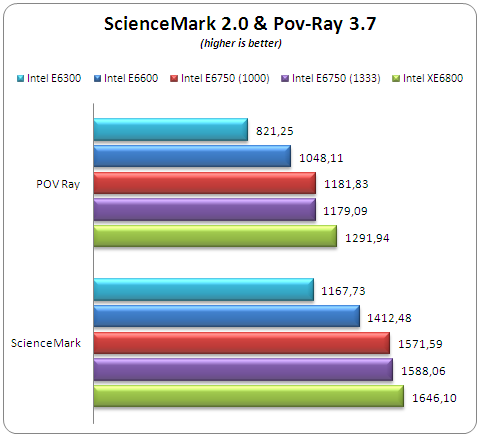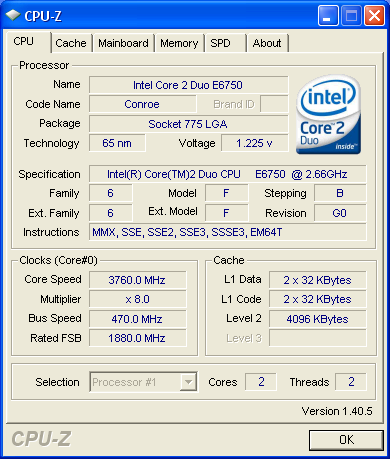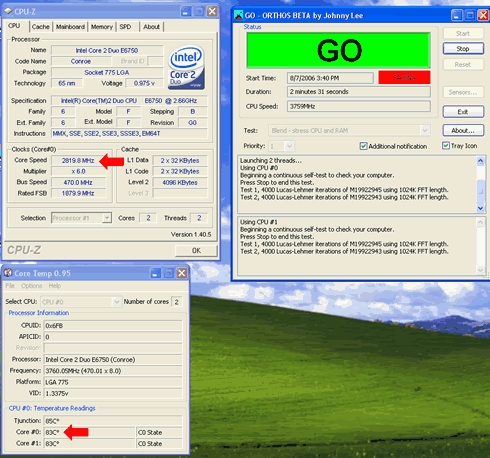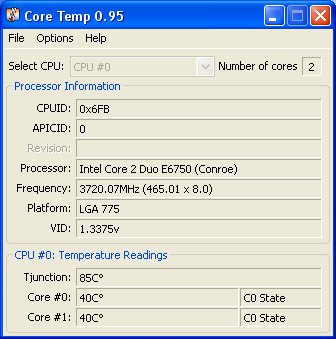1. Introduction
 Core 2 is a ninth-generation x86 architecture microprocessor produced by Intel and it was officially released on July 27, 2006. Processors are built on a 65 nm process and are intended for desktops, replacing the Pentium 4 and Pentium D. All Conroe processors are manufactured with 4 MB L2 cache.
Core 2 is a ninth-generation x86 architecture microprocessor produced by Intel and it was officially released on July 27, 2006. Processors are built on a 65 nm process and are intended for desktops, replacing the Pentium 4 and Pentium D. All Conroe processors are manufactured with 4 MB L2 cache.
 Intel Core 2 processors feature x86-64, Virtualization Technology, Execute Disable Bit, and SSSE3. The release also introduced LaGrande Technology, Enhanced SpeedStep Technology, and Active Management Technology (iAMT2).
Intel Core 2 processors feature x86-64, Virtualization Technology, Execute Disable Bit, and SSSE3. The release also introduced LaGrande Technology, Enhanced SpeedStep Technology, and Active Management Technology (iAMT2).
Intel released four additional Core 2 Duo Processors on July 22nd, 2007. The release coincided with that of the Intel Bearlake (x3x) chipsets. The new processors are the Core 2 Duo E6540, E6550, E6750, and E6850. Processors with a number ending in "50" have a 1333 MT/s FSB. The processors all have 4 MB of L2 cache. Their clock frequency is similar to that of the already released processors with the same first two digits (E6600, E6700, X6800)
- Comparison
|
Intel Core2Duo Processor E6750
|
Intel Core2Duo Processor E6700
|
| Processor Number |
E6750 |
E6700 |
| Architecture |
65 nanometer technology |
65 nanometer technology |
| L2 Cache |
4M |
4M |
| L3 Cache |
N/A |
N/A |
| Clock Speed |
2.66 GHz |
2.66 GHz |
| Front Side Bus Speed |
1333 MHz |
1066 MHz |
| Other Intel Technologies |
Intel 64,
EIST
XD,
IVT,
Dual-core,
Intel Trusted Execution Technology |
Intel 64,
VT±,
Execute Disable Bit,
Multi-Core,
EIST |
| Package |
FC-LGA |
FC-LGA |
| Slot/Socket Type |
LGA775 |
LGA775 |
| Pin Count |
775-land |
775-land |
| sSpec Number |
SLA9V |
SL9S7 |
The major difference between the E6700 and E6750 is the increased FSB of 1333Mhz for the E6750 processor, compared with the 1066MHz FSB of the E6700. That should give increased performance in almost all applications, provided that it's combined with the proper memory configuration. The Intel E6750 series is meant to be combined with the Intel Bearlake (P35) chipset that natively supports 1333MHz FSB and of course, DDR3 memory.
Currently, there is no available DDR2 memory that can support 1333MHz, even at relaxed timings. That should give users a clear way to improve their performance by combining an E6750 and a P35 based motherboard. Of course, it also means additional cost for most users. However, most currently sold P965 motherboards support 1333Mhz, so there is the question, is upgrading to an E6750 processor and DDR3 1333MHz memory worth the extra cost. We plan to find out in our review!
- Compatibility
Most P965 motherboards should support 1333FSB, just check with your motherboard manufacturer and make sure to update to the latest available BIOS. All currently sold P35 based motherboards support 1333FSB so there should be no real compatibility issue there.
2. Retail package
Recently, Intel dropped prices for all C2D processors, making the E6750 a best buy option for all class of users. You can find the E6750 for around €175 (+shipping) in Europe. The retail package has changed a bit compared with previous C2D series:

There is still the label with full product details:

- Installation
There isn't much to say here, other than be careful when installing the CPU! After connecting all necessary power cables, you can power up your system.
Everest Ultimate Edition 2007 gives us all the information we need about the processor capabilities. The CPU multiplier ranges from 6x~8x and that should give us plenty of overclocking room:

CPU-Z also has some information for us:


3. Test Configuration
In order to test the Intel E6750, we used two testbeds. One with Intel P965 and DDR2 memory, and one with P35 and DDR3 memory. For comparison, we also post results from other tested Intel C2D processors. Unfortunately, we didn't have in our labs an E6700 for direct comparison, but the current results should still be a good indication for most users.
DDR2 Memory Testbed
- CPU: Retail Intel E6750
- CPU Cooler: Arctic Cooling Freezer 7
- Motherboard: Asus P5B Premium VISTA Edition BIOS 0705
- Memory: 2x1GB Crucial PC-8000 (1000MHz @ 5-5-5-15 Divider 2:3, 2.25V)
- VGA: MSI 7600GT Silent with Nvidia 93.71 installed
- HDD: WD 80GB SATAI (primary)
- HDD: Seagate 80GB SATAII (secondary)
- Operating system: Windows XP SP2 with all latest updates installed



DDR3 Memory Testbed
- CPU: Retail Intel E6750
- CPU Cooler: Arctic Cooling Freezer 7
- Motherboard: Asus P5K3 Deluxe BIOS 0604
- Memory: 2x1GB SuperTalent PC3-1600 CL7 (1333MHz @ 6-6-6-15 Divider 1:2, 1.80V)
- VGA: MSI 7600GT Silent with Nvidia 93.71 installed
- HDD: WD 80GB SATAI (primary)
- HDD: Seagate 80GB SATAII (secondary)
- Operating system: Windows XP SP2 with all latest updates installed
As you can see, the only changes in the testbeds are the motherboard and memory. The memory timings are probably the most significant and should highlight any performance differences.
For DDR2, we chose 1000MHz and not higher, due to the 333FSB that did not provide a higher memory divider option. For DDR3, we chose 1333MHz at CL6 to get the best possible performance (1:2 divider). Finally, for the overclocking tests, we chose to work on the DDR3 platform and see how high we could get our Intel E6750 CPU to go.
We used a variety of benchmark software to measure the performance of the processor:
- Sisoft Sandra 2007 SP1
- Everest Lavasys Ultimate Edition 2006 v3.00.717 beta
- SuperPI Mod v1.5XS
- PC Mark05 v1.1.0
- 3D Mark06 v1.2.0
- Recode v2.3.1.8
- Science Mark 06
- POV 3.70 beta15
- Cinebench v9.5
4. Everest Ultimate Edition 2006 - SiSoft Sandra
 EVEREST Ultimate Edition is an industry leading system diagnostics and benchmarking solution for enthusiasts PC users, based on the award-winning EVEREST Technology. During system optimizations and tweaking it provides essential system and overclock information, advanced hardware monitoring and diagnostics capabilities to check the effects of the applied settings. CPU, FPU and memory benchmarks are available to measure the actual system performance and compare it to previous states or other systems. Furthermore, complete software, operating system and security information makes EVEREST Ultimate Edition a comprehensive system diagnostics tool that offers a total of 100 pages of information about your PC. The software has several built-in tests for memory and CPU/FPU.
EVEREST Ultimate Edition is an industry leading system diagnostics and benchmarking solution for enthusiasts PC users, based on the award-winning EVEREST Technology. During system optimizations and tweaking it provides essential system and overclock information, advanced hardware monitoring and diagnostics capabilities to check the effects of the applied settings. CPU, FPU and memory benchmarks are available to measure the actual system performance and compare it to previous states or other systems. Furthermore, complete software, operating system and security information makes EVEREST Ultimate Edition a comprehensive system diagnostics tool that offers a total of 100 pages of information about your PC. The software has several built-in tests for memory and CPU/FPU.

Memory performance was very good for all Intel processors. Theoretically, the Intel E6750 with DDR3 memory should rule in all memory tests, and this is confirmed in the above tests. In the CPU tests, the difference between the 1000MHz and 1333MHz setups is very slight:

The FPU tests also don't really show any difference between the E6750 running with DDR2 or DDR3 memory..

From the above benchmarks, we have the following results:
- Intel E6750 with DDR3 @ 1333MHz is 7.65% slower than Intel XE6800
- Intel E6750 with DDR2 @ 1000MHz is 8.29% slower than Intel XE6800
- Intel E6600 with DDR2 @ 1067MHz is 16.14% slower than Intel XE6800
- Intel E6300 with DDR2 @ 1067MHz is 47.32% slower than Intel XE6800
The above statements are valid only for Everest Ultimate Edition CPU/FPU tests. Let's proceed to the Sisoftware Sandra benchmarks.
 SiSoftware Sandra (the System ANalyser, Diagnostic and Reporting Assistant) is an information & diagnostic utility. It should provide most of the information (including undocumented) you need to know about your hardware, software and other devices whether hardware or software. It works along the lines of other Windows utilities, however it tries to go beyond them and show you more of what's really going on. Giving the user the ability to draw comparisons at both a high and low-level. You can get information about the CPU, chipset, video adapter, ports, printers, sound card, memory, network, Windows internals, AGP, PCI, PCIe, ODBC Connections, USB2, 1394/Firewire, etc. Sisoft Sandra offers a variety of tests for Memory and CPU.
SiSoftware Sandra (the System ANalyser, Diagnostic and Reporting Assistant) is an information & diagnostic utility. It should provide most of the information (including undocumented) you need to know about your hardware, software and other devices whether hardware or software. It works along the lines of other Windows utilities, however it tries to go beyond them and show you more of what's really going on. Giving the user the ability to draw comparisons at both a high and low-level. You can get information about the CPU, chipset, video adapter, ports, printers, sound card, memory, network, Windows internals, AGP, PCI, PCIe, ODBC Connections, USB2, 1394/Firewire, etc. Sisoft Sandra offers a variety of tests for Memory and CPU.


The Sisoft Sandra CPU/FPU tests produce the following results:
- Intel E6750 with DDR3 @ 1333MHz is 8.75% slower than Intel XE6800
- Intel E6750 with DDR2 @ 1000MHz is 9.89% slower than Intel XE6800
- Intel E6600 with DDR2 @ 1067MHz is 20.10% slower than Intel XE6800
- Intel E6300 with DDR2 @ 1067MHz is 44.66% slower than Intel XE6800
5. PCMARK - 3DMARK
 PCMark®05 is everything you need to reliably and easily measure the performance of your PC and determine its strengths and weaknesses. With PCMark05, you will be able to select the optimal upgrades for your existing PC, or choose the right new PC that fits your specific needs. This easy-to-use product gives you the same tools and knowledge that virtually every professional tester in the industry uses. Below you can see the scores for memory and CPU.
PCMark®05 is everything you need to reliably and easily measure the performance of your PC and determine its strengths and weaknesses. With PCMark05, you will be able to select the optimal upgrades for your existing PC, or choose the right new PC that fits your specific needs. This easy-to-use product gives you the same tools and knowledge that virtually every professional tester in the industry uses. Below you can see the scores for memory and CPU.

Looking at the CPU scores:
- Intel E6750 with DDR3 @ 1333MHz is 9.64% slower than Intel XE6800
- Intel E6750 with DDR2 @ 1000MHz is 9.90% slower than Intel XE6800
- Intel E6600 with DDR2 @ 1067MHz is 22.02% slower than Intel XE6800
- Intel E6300 with DDR2 @ 1067MHz is 56.66% slower than Intel XE6800
 3DMark®06 is the worldwide standard in advanced 3D game performance benchmarking. A fundamental tool for every company in the PC industry as well as PC users and gamers, 3DMark06 uses advanced real-time 3D game workloads to measure PC performance using a suite of DirectX 9 3D graphics tests, CPU tests, and 3D feature tests. 3DMark06 tests include all new HDR/SM3.0 graphics tests, SM2.0 graphics tests, AI and physics driven single and multiple cores or processor CPU tests and a collection of comprehensive feature tests to reliably measure next generation gaming performance today.
3DMark®06 is the worldwide standard in advanced 3D game performance benchmarking. A fundamental tool for every company in the PC industry as well as PC users and gamers, 3DMark06 uses advanced real-time 3D game workloads to measure PC performance using a suite of DirectX 9 3D graphics tests, CPU tests, and 3D feature tests. 3DMark06 tests include all new HDR/SM3.0 graphics tests, SM2.0 graphics tests, AI and physics driven single and multiple cores or processor CPU tests and a collection of comprehensive feature tests to reliably measure next generation gaming performance today.

3D Mark 06 also measures CPU performance where we have:
- Intel E6750 with DDR3 @ 1333MHz is 8.45% slower than Intel XE6800
- Intel E6750 with DDR2 @ 1000MHz is 8.27% slower than Intel XE6800
- Intel E6600 with DDR2 @ 1067MHz is 21.80% slower than Intel XE6800
- Intel E6300 with DDR2 @ 1067MHz is 56.53% slower than Intel XE6800
6. Science Mark - PovRay - Nero Digital
 Science Mark 2.0 is an attempt to put the truth behind benchmarking. In an attempt to model real world demands and performance, SM2 is a suite of high-performance benchmarks that realistically stress system performance without architectural bias. Science Mark 2.0 is comprised of 7 benchmarks, each of which measures a different aspect of real world system performance.
Science Mark 2.0 is an attempt to put the truth behind benchmarking. In an attempt to model real world demands and performance, SM2 is a suite of high-performance benchmarks that realistically stress system performance without architectural bias. Science Mark 2.0 is comprised of 7 benchmarks, each of which measures a different aspect of real world system performance.
Pov-Ray s a high-quality, totally free tool for creating stunning three-dimensional graphics. It is available in official versions for Windows, Mac OS/Mac OS X and i86 Linux. The source code is available for those wanting to do their own ports. We used Pov-Ray 3.7beta15 for all tests, since it supports Dual Core CPUs. We used the built-in benchmark as suggested by the developers.

In ScienceMark we have:
- Intel E6750 with DDR3 @ 1333MHz is 3.65% slower than Intel XE6800
- Intel E6750 with DDR2 @ 1000MHz is 4.74% slower than Intel XE6800
- Intel E6600 with DDR2 @ 1067MHz is 16.54% slower than Intel XE6800
- Intel E6300 with DDR2 @ 1067MHz is 40.97% slower than Intel XE6800
While in Pov-Ray:
- Intel E6750 with DDR3 @ 1333MHz is 9.57% slower than Intel XE6800
- Intel E6750 with DDR2 @ 1000MHz is 9.32% slower than Intel XE6800
- Intel E6600 with DDR2 @ 1067MHz is 23.26% slower than Intel XE6800
- Intel E6300 with DDR2 @ 1067MHz is 57.31% slower than Intel XE6800
- Nero Digital
One of the major advantages of having a Quad Core CPU becomes apparent when encoding Video. Nero Digital is one of the best known Digital formats, offering both ASP and AVC encoder profiles.

_Profiles.png)
For our tests, we used the latest version of Nero Recode v2.3.1.8 as packaged with Nero Reloaded v7.5.0.1. As a source, we used a VOB file of 5 mins duration. We encoded for each processor in two modes (ASP, AVC) with exactly the same preferences (Same bitrate and Dual pass). The encoding time displayed below is what Nero Recode reported. The lower the time taken, the better. All results are displayed in seconds.

Summing the difference in both tests (AVC and ASP) we have
- Intel E6750 with DDR3 @ 1333MHz is 10.37% slower than Intel XE6800
- Intel E6750 with DDR2 @ 1000MHz is 11.64% slower than Intel XE6800
- Intel E6600 with DDR2 @ 1067MHz is 39.48% slower than Intel XE6800
- Intel E6300 with DDR2 @ 1067MHz is 69.37% slower than Intel XE6800
7. CINEBENCH -SuperPI
 CINEBENCH is the free benchmarking tool for Windows and Mac OS based on the powerful 3D software CINEMA 4D. Consequently, the results of tests conducted using CINEBENCH 9.5 carry significant weight when analyzing a computer’s performance in everyday use.
CINEBENCH is the free benchmarking tool for Windows and Mac OS based on the powerful 3D software CINEMA 4D. Consequently, the results of tests conducted using CINEBENCH 9.5 carry significant weight when analyzing a computer’s performance in everyday use.
Especially a system’s CPU and the OpenGL capabilities of its graphics card are put through their paces (even multiprocessor systems with up to 16 dedicated CPUs or processor cores). During the testing procedure, all relevant data is ascertained with which the performance of different computers can subsequently be compared, regardless of operating system. All tests were done with the latest available build (R9.5), and the sum of the subtests is displayed in the following chart, except for OpenGL Software & Hardware Lighting tests, since these depend on the installed VGA card.

CineBench is one of the few benchmarks that supports multi-core CPUs. Again the differences are not that great between E6750 DDR3 vs DDR2 memory:
SuperPI has become an utility to benchmark modern systems. In August 1995, the calculation of pi up to 4,294,960,000 decimal digits was succeeded by using a supercomputer at the University of Tokyo. The program was written by D.Takahashi and he collaborated with Dr. Y.Kanada at the computer center, the University of Tokyo. This record-breaking program was ported to personal computer environments such as Windows NT and Windows 95 and called Super PI.

The software offers up to 32M calculations of PI numbers. For all CPUs, we tested up to 8M calculations:




Both E6750 setups are again very close in their performance and not that far behind the performance of the XE6800.
8. Overclocking
All currently sold Intel C2D processors are very good overclockers, this is no secret. The "new" Intel E6750 with 1333MHz FSB bus is supposed to be an especially good processor to play with and reach at very high speeds, nearly 4GHz! If that sounds impossible, read on...

With an air cooled solution, we managed to get an impressive 3.80GHz, which however wasn't very stable. The problem was not the CPU itself but the cooling system. The processor was reaching very high temperatures resulting in not proper operation. So we had to lower the FSB and memory voltage:

3.760 was very good, the system appeared rock solid. However, we noticed an abonrmal behaviour:

The temperatures were above 80° C resulting in an automatic reduction in CPU speed in order to avoid burning the processor. According to the specifications for an Intel Core2 Duo Desktop Processor E6750, the thermal specifiaction temperature is given as 72° C.
Finally, we managed to get a 100% stable system at 3.720GHz (465x8), with 70° C maximum temperature:

What impressed us is that the CPU cools down very quick, so in idle mode we have very low temperatures:

All overclocking tests were done with the following system and BIOS settings:
- CPU Cooler: Arctic Cooling Freezer 7
- Motherboard: Asus P5B Premium VISTA Edition BIOS 0705
- Memory: 2x1GB Crucial PC-8000 (930Hz @ 5-5-5-15, Divider 1:1, 2.10V)
- VGA: MSI 7600GT Silent with Nvidia 93.71 installed
- HDD: WD 80GB SATAI (primary)
- HDD: Seagate 80GB SATAII (secondary)
- Operating system: Windows XP SP2 with all latest updates installed
Asus P5B Premium BIOS settings
- FSB: 465
- PCI-E: 100
- PCI Clock: 33MHz
- Spread Spectrum: Disabled
- Memory Voltage: 2.10V (this depends on your memory)
- CPU Core: 1.4875V
- FSB Termination: 1.45V
- NB Core: 1.65V
- SB Core: 1.80V
- ICH Chipset Voltage: 1.215V
And finally, here are several test results after overclocking the Intel E6750 up to 3.72GHz. As you will notice, the performance improvement is... significant!







9. Conclusion
 The recent price drops in Intel C2D has for the first time offered very high computing power at affordable prices for all class of end users. The newly released E6750 comes with 4MB cache and 1333MH FSB, that promises to improve performance, compared with the "older" E6700 series. Most currently sold motherboards support 1333MHz FSB processors, at least those with Intel P965 and P35 chipsets.
The recent price drops in Intel C2D has for the first time offered very high computing power at affordable prices for all class of end users. The newly released E6750 comes with 4MB cache and 1333MH FSB, that promises to improve performance, compared with the "older" E6700 series. Most currently sold motherboards support 1333MHz FSB processors, at least those with Intel P965 and P35 chipsets.
This give users two possible configurations, pairing an Intel E6750 with DDR2 memory or pairing an Intel E6750 with DDR3 memory, that can fully utilise the 1333MHz. So which is the faster combination? Well, its obvious that the DDR3 setup has an advantage, but check first how much DDR3 costs nowadays!

We tested both, with DDR2 and DDR3 memory. From the test results we found that "on average" we had:
- Intel E6750 with DDR3 @ 1333MHz is 7.68% slower than Intel XE6800
- Intel E6750 with DDR2 @ 1000MHz is 8.22% slower than Intel XE6800
Our testbed includes many synthetic and real life applications. The average performance can be considered as reliable when comparing two systems. What is of special interest is that there was a difference between the DDR2 vs DDR3 of only 0.54% in favor of the DDR3 setup. We used SuperTalent's PC3-1600CL7 that allowed us to have the lowest CL6 at 1333MHz. On the other hand, with low priced DDR2 (Crucial PC2-8000) we had very good results in most tests. Unfortunately, we didn't have an E6700 in our labs to test.

So, our test results made it clear that the Intel E6750 can perform almost as well with DDR2 (either P965/P35 motherboards) as with DDR3.
How about overclocking capabilities? Here is where this processor simply... shines! We had heard that other reviewers had reached 4GHz, but we were very a little skeptical, until we reached 3.80GHz. Of course, the system wasn't totally stable, but we managed to get a totally stable system at 3.72GHz, which is very nice :-). The "problem" we encountered was that the CPU temperatures reaching the maximum point and even our Arctic Cooling Freezer 7 couldn't handle such a hot load. We imagine that with water cooling, the Intel E6750 can reach or even surpass the 4GHz barrier. In any case, overclocking up to 3.60GHz should be considered as very realistic, since most motherboards can handle 450MHz FSB.

We left the best for the end. The price! Yes its almost a steal at only €175 (+ shipping). You can now build a powerful system with DDR2 memory, an Intel E6750 and a good motherboard to keep you satisfied for a very long time... Well done Intel!